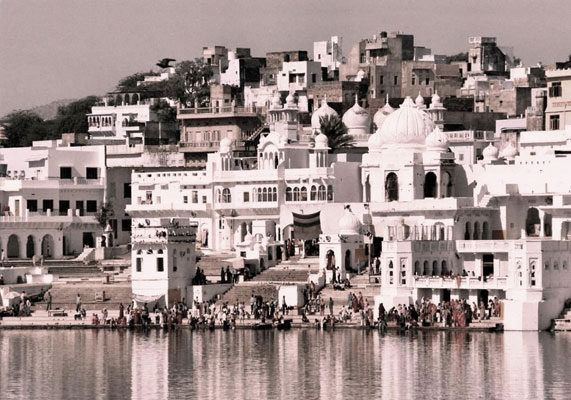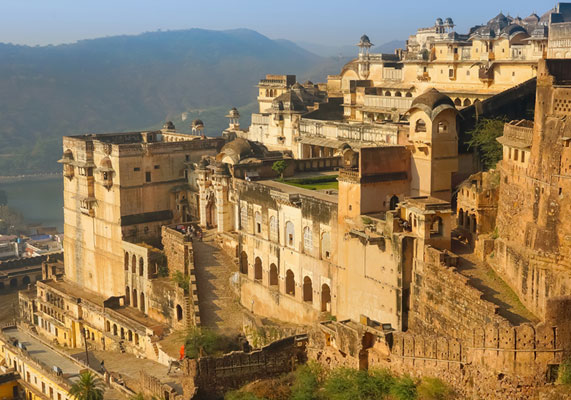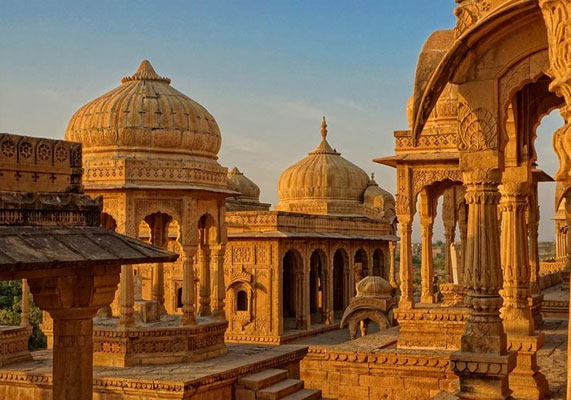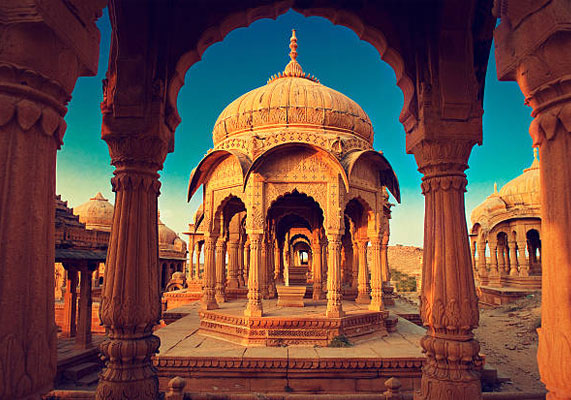Medieval and Early Modern
Prithviraj Chauhan defeated the invading Muhammad Ghori in the First Battle of Tarain in 1191. In 1192 CE, Muhammad Ghori decisively defeated Prithviraj at the Second Battle of Tarain. After the defeat of Chauhan in 1192 CE, a part of Rajasthan came under Muslim rulers. The principal centers of their powers were Nagaur and Ajmer. Ranthambhore was also under their suzerainty. At the beginning of the 13th century, the most prominent and powerful state of Rajasthan was Mewar. The Rajputs resisted the Muslim incursions into India, although a number of Rajput kingdoms eventually became subservient to the Delhi Sultanate.


The Rajputs put up resistance to the Islamic invasions with their warfare and chivalry for centuries. The Rana's of Mewar led other kingdoms in its resistance to outside rule. Rana Hammir Singh, defeated the Tughlaq dynasty and recovered a large portion of Rajasthan. The indomitable Rana Kumbha defeated the Sultans of Malwa, Nagaur and Gujarat and made Mewar the most powerful Rajput Kingdom in India. The ambitious Rana Sanga united the various Rajput clans and fought against the foreign powers in India. Rana Sanga defeated the Afghan Lodi Empire of Delhi and crushed the Turkic Sultanates of Malwa and Gujarat. Rana Sanga then tried to create an Indian empire but was defeated by the first Mughal Emperor Babur at Khanua. The defeat was due to betrayal by the Tomar King Silhadi of Raisen. After Rana Sanga's death, Marwar rose as a power center in Rajasthan under Rao Maldev Rathore. He conquered Jaisalmer, parts of Gujarat, Jalore, Nagaur, Ajmer, Sanchore, Bhinmal, Radhanpur, Bayana, Tonk, Toda and Nabhara. He expanded the territories of Marwar up to Sindh-Cholistan in west and his northern boundary was just fifty km from Delhi. After defeating Humayun, Sher Shah came towards Rajputana. He defeated Chiefs of Rathore army by trickery in Battle of Sammel and captured some territory of Marwar but it was recovered by Rathores in 1545. After that Rajputana remained mostly free from Islamic occupation till the Akbar's conquest of Rajputana.
Hem Chandra Vikramaditya, the Hindu Emperor, was born in the village of Machheri in Alwar District in 1501. He won 22 battles against Afghans, from Punjab to Bengal including the states of Ajmer and Alwar in Rajasthan, and defeated Akbar's forces twice, first at Agra and then at Delhi in 1556 at Battle of Delhi before acceding to the throne of Delhi and establishing the "Hindu Raj" in North India, albeit for a short duration, from Purana Quila in Delhi. Hem Chandra was killed in the battlefield at Second Battle of Panipat fighting against Mughals on 5 November 1556.
During Akbar's reign most of the Rajput kings accepted Mughal suzerainty, but the rulers of Mewar (Rana Udai Singh II) and Marwar (Rao Chandrasen Rathore) refused to have any form of alliance with the Mughals. To teach the Rajputs a lesson Akbar attacked Udai Singh and killed Rajput commander Jaimal of Chitor and the citizens of Mewar in large numbers. Akbar killed 20,000 – 25,000 unarmed citizens in Chittor on the grounds that they had actively helped in the resistance.
Maharana Pratap took an oath to avenge the citizens of Chittor, he fought the Mughal empire till his death and liberated most of Mewar apart from Chittor itself. Maharana Pratap soon became the most celebrated warrior of Rajasthan and became famous all over India for his sporadic warfare and noble actions. According to Satish Chandra, "Rana Pratap's defiance of the mighty Mughal empire, almost alone and unaided by the other Rajput states, constitutes a glorious saga of Rajput valor and the spirit of self-sacrifice for cherished principles. Rana Pratap's methods of sporadic warfare were later elaborated further by Malik Ambar, the Deccani general, and by Shivaji".


Rana Amar Singh I continued his ancestor's war against the Mughals under Jehangir, he repelled the Mughal armies at Dewar. Later an expedition was again sent under the leadership of Prince Khurram, which caused much damage to life and property of Mewar. Many temples were destroyed, several villages were put on fire and women and children were captured and tortured to make Amar Singh accept surrender.
During Aurangzeb's rule Rana Raj Singh I and Veer Durgadas Rathore were chief among those who defied the intolerant emperor of Delhi. They took advantage of the Aravalli hills and caused heavy damage to the Mughal armies that were trying to occupy Rajasthan.
After Aurangzeb's death Bahadur Shah I tried to subjugate Rajasthan like his ancestors but his plan backfired when the three Rajput Rajas of Amber, Udaipur, and Jodhpur made a joint resistance to the Mughals. The Rajputs first expelled the commandants of Jodhpur and Bayana and recovered Amer by a night attack. They next killed Sayyid Hussain Khan Barha, the commandant of Mewat and many other Mughal officers. Bahadur Shah I, then in the Deccan was forced to patch up a truce with the Rajput Rajas. The Jats, under Suraj Mal, overran the Mughal garrison at Agra and plundered the city taking with them the two great silver doors of the entrance of the famous Taj Mahal which were then melted down by Suraj Mal in 1763.
Over the years, the Mughals began to have internal disputes which greatly distracted them at times. The Mughal Empire continued to weaken, and with the decline of the Mughal Empire in the late 18th century, Rajputana came under the influence of the Marathas. The Maratha Empire, which had replaced the Mughal Empire as the overlord of the subcontinent, was finally replaced by the British Empire in 1818.